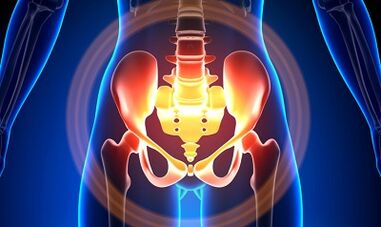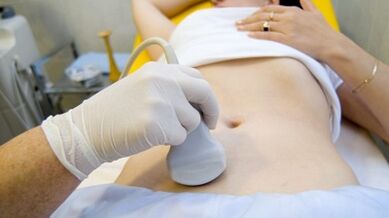
This disease is poorly studied, although several thousand observations with diagnosis and subsequent treatment have been described.
Lots of diversity and non -specificity of the clinical image of the varicose veins of the pelvis lead to serious diagnosis errors, which in the future affects the consequences.
Characterization of varicose veins of a small pelvis
The veins of the pelvis are several times more than the arteries, which determines their great capacity.This is due to the phylogenesis of the vascular system of the pelvic region.Pelvis veins have high adaptation skills and are potentially predisposed to restructuring, which contributes to the formation of a densely intertwined network.
The speed and direction of the blood flow are regulated by the valves, which are controlled by complex humoral mechanisms.Valves balance the pressure in different parts of the venous network.
When valves fail to perform their functions, blood stagnation develops, it leads to blood vessel pathology and varicose vein formation.The uniqueness of the small pelvis veins lies in the fact that the large ligaments of the uterus, which support the lumen of the vase in width, can also reduce it, causing a pathology.
Causes
The pathological dilation of the pelvis veins can be due to the following reasons:
- Violation of blood exit paths;
- Venous barrel imprisonment;
- Compression of collateral trunks by the altered position of the uterus, for example, in retroflexia;
- Valve ovary failure (congenital or acquired);
- Obstructive Post -Squesting Syndrome;
- Connective tissue pathology;
- Arteriovenous angiodysplasia;
- Prolonged physical work, sitting and hard;
- Veins veins from the lower ends;
- Pregnancy (3 or more) and childbirth (2 or more);
- Women's genital diseases (chronic SalpingoFriter, ovarian tumors, uterine fibroids and genital endometriosis);
- The adhesive process of the pelvic organs;
- Obesity.
Classification by degrees of the disease
In terms of expanded veins, the following degrees are distinguished:
- Up to 0.5 cm, vascular scam “bags”;
- 0.6-1 cm;
- More than 1 cm.
Options for the course of the disease
- Varicose veins of the perineum and vestibule of the vagina;
- Pelvis Venous Search Syndrome;
Symptoms
- The most common pain - frequent in the lower abdomen, perineum after long and dynamic stresses.The pain intensifies in the second phase of the cycle, after hypothermia, fatigue, stress, exacerbations of various diseases.
- The feeling "is not comfortable," pain with sex and then.
- Dysmenorrhea - Menstruation disorders, including pain syndrome.
- Secretion, more than normal, genital tract galls.
- Blood stagnation leads to infertility, disability, termination of pregnancy.
- Breakfast violations as a result of bladder veins expansion.
Diagnosis
The diagnosis of the disease only by complaints is successful in only 10 % of cases.
Palpation of the inner walls of the pelvis makes it possible to feel seals and we oblongs of veins.When examined in the mirrors, vagina mucous membrane cyanosis is visible.

The procedure for choice is an ultrasound study with color Doppler mapping, which allows not only ovarian vein extensions, but also venous thrombosis, post -climate occlusion.With ultrasound, it is visible, "worms", the structure without signal reflection, located on the lateral surface of the uterus.
The effect of the Doppler study is based on "dyeing" in blue and red color, venous and arterial blood, corresponding.
The device for ultrasonic examination using a special program recognizes the movement of the blood of the sensor and, in the other direction, calculates the speed of blood flow and the type of vase.
But the exact definition of the vein is or the artery remains behind the doctor.The Doppler method works in almost every case, our body determines exceptions to the rules, since the blood that flows from the heart is not always arterial and vice versa.
Thus, an ultrasonic diagnosis sees an arterial or venous vessel, its size, blood flow and many indicators that an ordinary person does not need, but plays an important role in the diagnosis.To do this, use transabdominal and transvaginal sensors.
In 5.7% of cases, the disease is recognized by accident during screening.Normally, the diameter of the ovaric vein is 0.4 cm.
CT and RM have great accuracy.Using these methods, you can find varicose veins in the uterus, ovaries and around these organs.It is possible to determine the concomitant pathology.
A very reliable method is a phlebographic study.
The contrast is performed at the height of the Valsalva sample against blood flow.This allows you to see valve failure.
Renal phlebography, Super -SEQUENIC FREMBOGRAPHY, and phlegoography on both sides are also used.These methods allow you to determine the hemodam and the anatomical changes in the kidney veins and the places of falling into them gonadny veins.
PHLEBOVARIOSCOPY SUPER -COMPENSED IS PERFORMED BY CATHETERISM OF GONNATED SEVERS THROUGH A FEMOR AGAINST MATTER OR SUBCLAVIA, WITH THE SUBSEQUENT INTRACTION OF CONTRACT.
Most of the plexus blood without horns is thrown away through the ovarian vein.But under hypertension conditions, it occurs through unconstrated uterine veins in the internal iliac vein.The plexus of the veins, through which the exit may occur, includes sacral and bladder plexus.
In left flexes' phlebography, 3 stages of venous stagnation are distinguished in the left ovary cluster plexus:
- There is no output of the left ovary plexus or is performed along an additional short path.
- There is an additional long way.
- Two additional output paths or an additional and auxiliary are visible.
In 2 and 3 stages, the varicose veins of the right ovary cluster plexus are formed.
Laparoscopy is used for differential diagnosis.The pathologically complicated veins are in the ovary, towards the round and wide ligaments.They look like great cyanotic conglomerates with a thin and tense wall.
The complexity of the diagnosis lies in the fact that the disease is often hidden behind the signs of the inflammatory process, is distinguished by clinical manifestations, masked under endometriosis, prolapse of internal organs, post -operative neuropathies and many extragenital diseases.
Treatment
The main objective of treatment is to remove reflux in the veins.In the early stages of the disease, conservative treatment is used.In the final stages of the disease, the treatment of choice is surgery.
Conservative treatment

It consists in normalizing the tone of the veins, the improvement of hemodynamics and trophic processes.
Symptomatic treatment to eliminate individual symptoms.Anti -non -steroidal inflammatory for pain, with bleeding - hemostatic therapy.
The main drugs in conservative treatment are venotonic medications and antiplatelets.
Phlebotonics - Improve the tone of the vascular wall and increase the blood flow.With this disease, it is best to consult a gynecologist about certain medications.
An important method is physical therapy exercises.
Surgical treatment
- Revival varicose veins.
- Gonada-CAAVALIA diverting.
- Laparoscopy sclerosis.
- Ovary veins occurs using x-ray-ray-ray methods.
Popular remedies
As the main thing in the occurrence of the disease is the weakness of the valve apparatus, all folkloric remedies that are used for expansion of vein varicose veins are also used for this pathology.
The most commonly used: hazelnut, hops, nettles, horse nut, lion tooth root, tea mushroom, willow, oak, St. John's weed, a series, flower pollen and much more plants.
Effective is: treatment with oak baths, chestnut, willow, chamomile, pharmacy, drying herbs, St. John weed.
Prevention
- The first thing to do if there are complaints, predictors or diseases listed above - contact a gynecologist.
- It is necessary to normalize the work regime and rest, try not to remain upright for a long time, physical tension.
- Perform exercises for the prevention "pedal", "stand-up", "legs of the foot"
- Answering the diet: Eat foods with a high vitamin content and, r, c, try to eat only white meat, less fat, replace it with fruits, vegetables, cereals.
- Drink enough liquid, but not less than 1.5 liters per day.
- Get free of overweight, bad habits.
- Consult the assistant doctor about the use of compression linen, he will improve blood output from the lower ends;Thus, there will be less stagnation in the pelvis.
- Avoid baths, saunas, steam rooms, hot baths.
In order not to get sick with such a difficult disease, it is necessary to follow the preventive recommendations listed above.Treat your health as the most valuable in life.
With the smallest suspicious symptoms you cannot get rid of for several days, consult a doctor.It must provide highly qualified help and save it from suffering.























